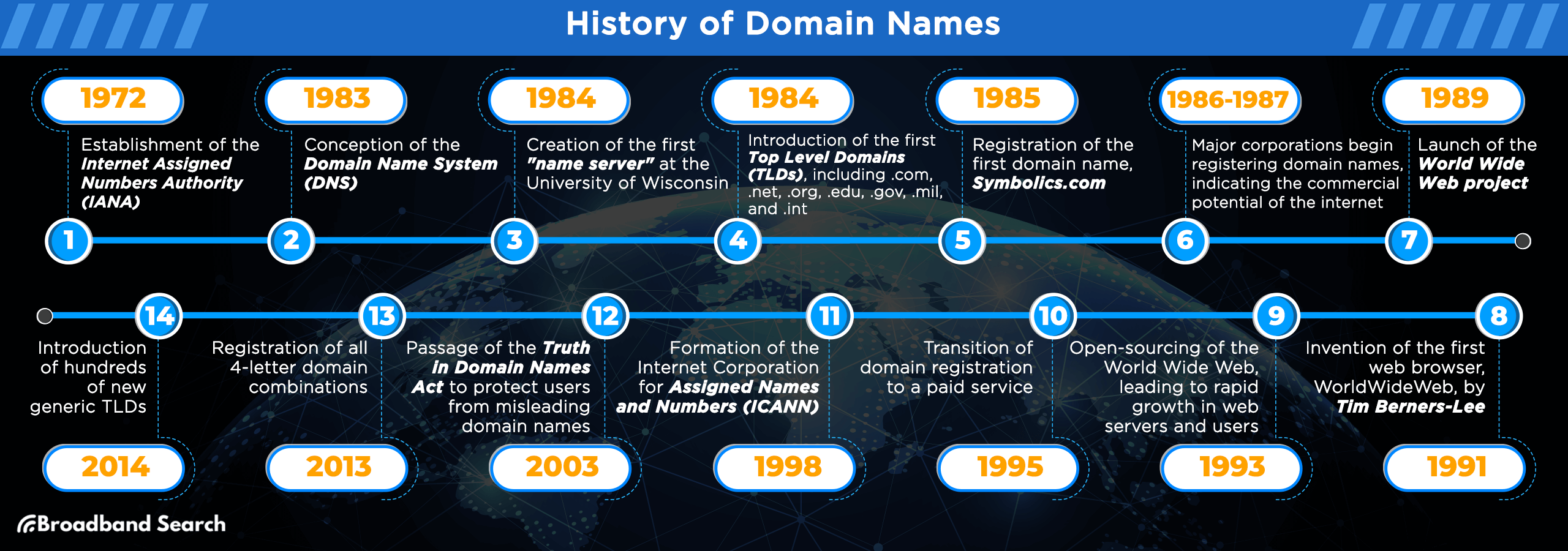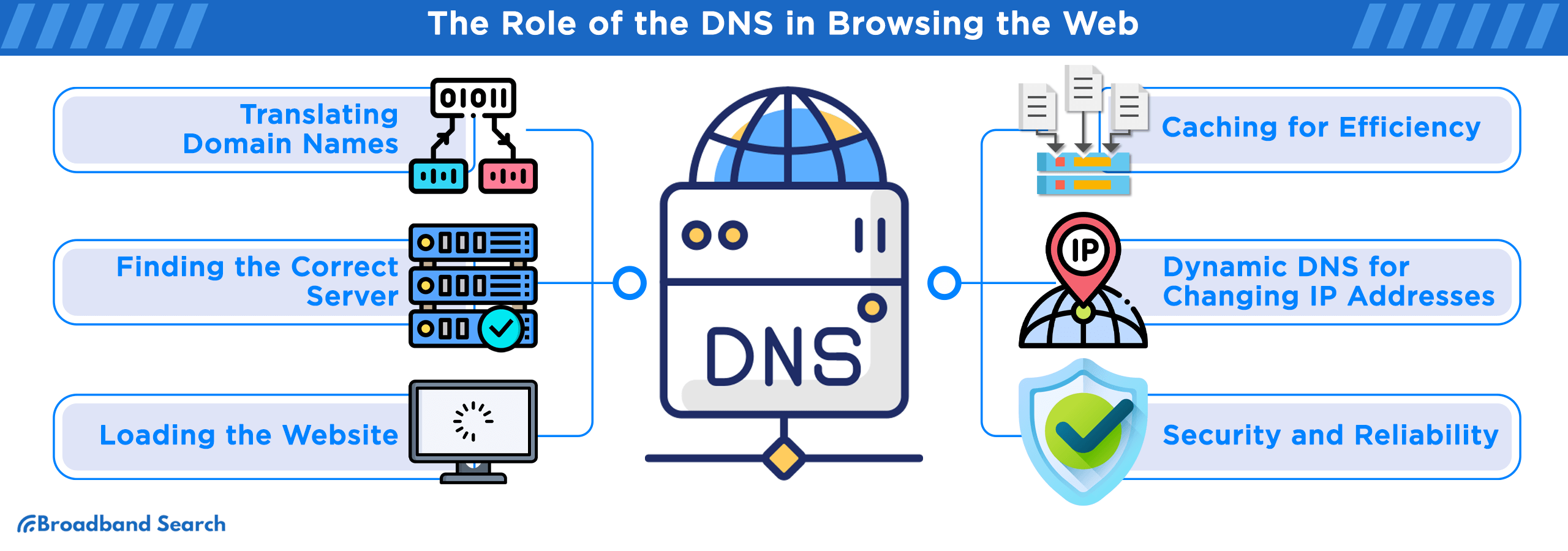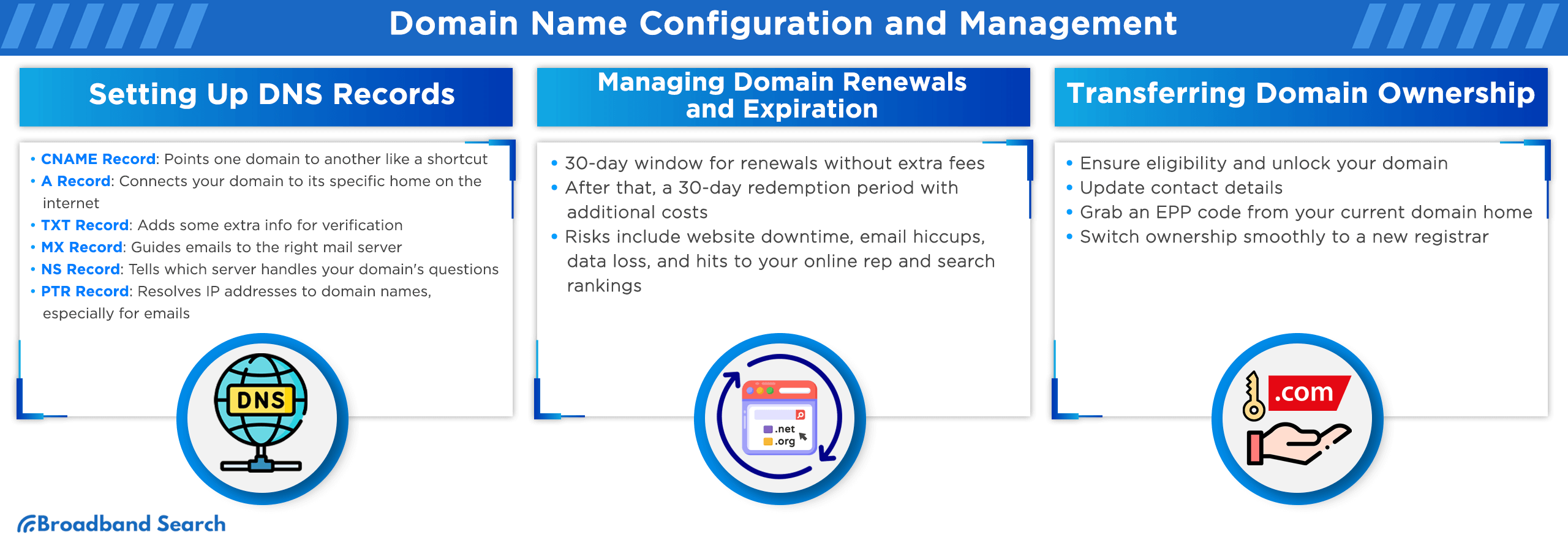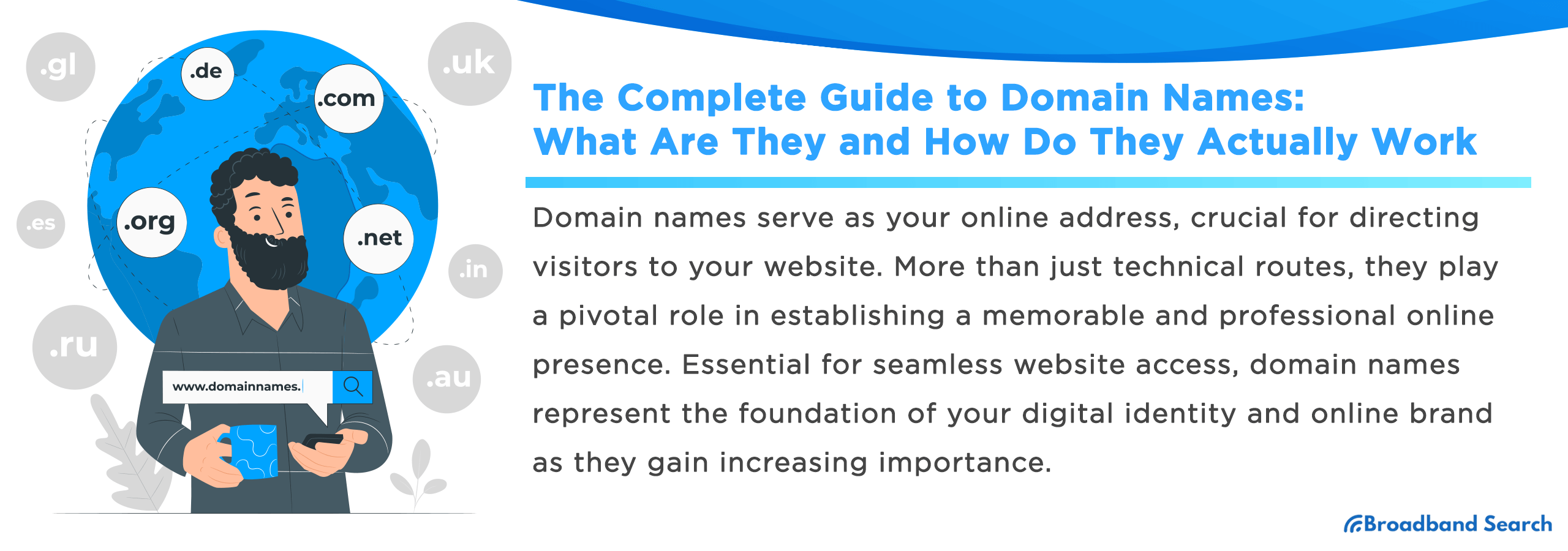Key Takeaways
- Choosing the right domain name is crucial for immediate brand recognition, building user trust, and improving your SEO performance.
- A full domain address is structured. It consists of a top-level domain (TLD), a second-level domain (the unique name you choose), and, ideally, subdomains that sit before it.
- DNS translates human-readable domain names into machine-readable IP addresses.
- Register your domain name and lock it down with privacy features and simple renewal management.

What Is a Domain Name (and Other Key Terms)?
- Domain Name: An easy-to-understand address used to access websites, like google.com or wikipedia.org. It's much easier to remember than a string of numbers.
- DNS (Domain Name System): The "phonebook" of the internet. DNS translates the human-readable domain names you type into your browser into the machine-readable IP addresses that computers need to connect you to the correct website.
- URL (Uniform Resource Locator): The complete web address for a specific page or resource on a website. It includes the domain name, along with other information such as the protocol (https://) and the specific page path (/contact).
- Web Hosting: Web hosting is a service that stores your website's files and data on a server and makes them accessible to visitors on the internet. A domain name points visitors to this hosting location.

Anatomy of a Domain Name
| Part | Description | Function |
|---|---|---|
| Top-Level Domain (TLD) | The suffix at the very end of the domain (e.g., .com, .org). | Categorizes the website broadly by type or geographic location (e.g., commercial, non-profit, government, educational, or country-specific) |
| Second-Level Domain (SLD) | The unique, customizable name directly to the left of the TLD (e.g., Google in Google.com). | Identifies the brand or organization that owns the domain. This is the main, memorable part that users associate with the website. |
| Subdomain | An optional prefix added to the left of the SLD (e.g., blog in blog.google.com). | Organizes or separates different sections or services of a website while keeping them under the same primary domain name. |
Top-Level Domains (TLDs)
Top-level domains (TLDs) like .com, .org, and .net categorize websites by their intended purpose. Choosing the best TLD for you helps set user expectations and reinforces your brand.
- The .com (commercial) is the most widely recognized, used by businesses and general sites to convey authority and trust.
- The .org (organization) extension primarily serves non-profits and community groups, signaling a mission-driven purpose.
- The .net (network) domain acts as a standard, versatile alternative to .com.
Second-Level Domains
A second-level domain (SLD) is a unique, brandable name positioned directly before the top-level domain (TLD) in a web address—for instance, "Google" in google.com.
An SLD is vital for a site's identity, brand recognition, and memorability, as it is the name users primarily remember. Selecting an effective SLD is a strategic decision that influences marketing and SEO efforts.
In some country codes, the SLD indicates the entity type, such as .co in .co.uk.
Subdomains
Subdomains create a logical hierarchy within a domain name, acting as distinct sections or separate sites under a main website.
Subdomains are formed by adding a prefix, like "blog" in blog.example.com, before the second-level domain.
Website administrators use subdomains to organize specific services or content—such as an online store (shop.example.com) or a mobile site (m.example.com)—allowing these areas to operate independently while remaining associated with the main domain.
Types of Domain Names
- Generic Top-Level Domains (gTLDs): Generic TLDs are the original core extensions of the internet, designed for general use regardless of where you are. gTLDs include the most recognizable domains such as .com, .org, and .net.
- Country-Code Domains (ccTLDs): ccTLDs are two-letter extensions specifically reserved for a country, sovereign state, or dependent territory (e.g., .uk for the United Kingdom, .ca for Canada, or .jp for Japan).
- Sponsored and New TLDs: More recent additions, such as .app, .club, and .store, allow businesses and individuals to select a domain name that instantly communicates the website's purpose, offering clarity and branding opportunities.

How the Domain Name System (DNS) Works
The Domain Name System (DNS) functions as the internet's phonebook, translating human-friendly domain names (like www.google.com) into machine-readable Internet Protocol (IP) addresses (like 142.250.184.14).
Key Components
The DNS system uses several key components to translate names to IP addresses.
Follow the following steps to retrieve the correct IP address for a website.
- A resolver acts as a go-between for your device and the internet.
- If the requested information is not cached, the resolver first queries one of the root servers, which points it toward the correct top-level domain (TLD) server.
- The TLD server then directs the resolver to the authoritative nameserver.
- The authoritative nameserver, which is the definitive source, provides the specific IP address needed to connect to the website.
Why DNS Matters: Speed, Reliability, and Browsing Experience
DNS is essential to a smooth web experience because it directly impacts speed, reliability, and ease of use. Fast DNS translation ensures quick page loads and reduces user frustration. Reliable DNS ensures websites consistently load without connection errors, making the internet feel fast and intuitive and allowing users to browse using simple, memorable names rather than complex IP addresses.
How to Register a Domain Name
Step 1: Choose a Domain Name
- Keep it short and memorable
- Align with your brand
- Avoid numbers and hyphens
- Check for trademarks
Step 2: Check for Availability
Use the search tool on a domain registrar's website to check whether your desired name is available with your preferred extension (e.g., .com, .org, or a newer TLD like .app or .store).
If your first choice is taken, registrars often suggest variations or alternative extensions.
Step 3: Select a Domain Registrar
When choosing a company to register your domain name, focus on three simple things:
- Pricing: Look for clear costs. Some registrars offer a very cheap first year but charge much more to renew later.
- Support: Pick a company with good customer support. If something goes wrong with your website address, you want quick, easy support.
- Reputation: Choose a well-known, trusted registrar. A good reputation means they are reliable and won't surprise you with hidden fees or problems later on.
Choose a reputable, ICANN-accredited provider that offers:
- Transparent pricing
- Domain privacy protection
- Easy DNS management
- Bundled e-mail
Step 4: Purchase and Finalize Registration
- Add the domain to your cart.
- Provide accurate contact details.
- Complete payment.
- Verify your email address.
- Enable auto-renewal.
Renewal and Auto-Renew Tips
The best strategy is to turn on auto-renewal in your registrar's settings. It automatically charges your payment method before the expiration date, ensuring continuous ownership without you having to remember the exact date.
Keep your contact and payment information up to date in your account settings. Updating outdated information ensures you receive important email reminders about upcoming renewals and that the automatic payment goes through without a hitch.

How to Configure and Manage Your Domain
Configuring and managing your domain correctly is essential for ensuring your website is accessible, secure, and performs optimally.
- Log in to your domain registrar's or web host's control panel (e.g., GoDaddy, Namecheap, Bluehost).
- Navigate to the DNS settings or "Manage DNS" section.
- Add a new record by selecting the appropriate type (A, CNAME, MX, or TXT) from a dropdown menu.
- Enter the required details (Name/Host, Value/Destination, TTL, Priority). The details are usually provided by the service you are connecting to (e.g., a web host, email provider, etc.).
- Save the record.
- Wait for changes to take effect. It can take anywhere from a few minutes to 72 hours.
The Business Side of Domain Names
Owning a domain name is more than just having an address for a website; it can be a valuable digital asset, much like real estate. This is the "business side" of domain names.
Domain investing (often called "domaining") is the practice of buying domain names with the intent to sell them later for a profit, a process known as domain flipping. The goal is to acquire names that have inherent value due to their shortness, memorability, relevance to a popular industry, or use of valuable keywords.
Domain flipping can bring in plenty of profit, passive income, and flexibility. At the same time, there is no guarantee of profit; you’ll have ongoing costs, and the market is volatile.

Domains and Branding
The right domain name builds credibility and SEO value primarily by shaping user experience and brand perception, which, indirectly but significantly, influences how search engines view and rank a website.
Here’s how Tesla’s move from TeslaMotors.com to Tesla.com illustrates smart domain branding strategy:
Tips for choosing a memorable, keyword-rich name include:
- Streamline Brand Identity: The single word Tesla.com is cleaner and more memorable.
- Reflect Expansion: The company was growing beyond just electric vehicles ("Motors") into a broader energy solutions provider (solar, batteries), making the shorter name more inclusive of its full range of offerings.
- Enhance Recognition & Usability: A simpler domain boosts global recognition and makes the web address easier for customers to remember, type, and share.
How to Secure Your Domain
Security Basics
- WHOIS Privacy Protection: When you register a domain name, international rules require your personal contact information (name, address, email, phone number) to be listed publicly in a database called WHOIS.
- Two-Factor Authentication (2FA): Two-factor authentication adds an essential second layer of security to your domain registrar account login.
- Registrar Locks (Transfer Locks): A registrar lock is a security setting applied directly to your domain name, rather than to your account login.
Legal Protection
A trademark is a legal protection for words, phrases, logos, or symbols that identify and distinguish a business's goods or services from others.
Why trademarks matter for domains: Registering a domain name that is identical or similar to someone else's existing trademark can land you in legal trouble. This is sometimes referred to as cybersquatting; registering a domain name in bad faith with the intent to profit from another brand’s good reputation.
How trademarks provide protection: If you have a valid trademark registration, you have the legal right to stop others from using a similar domain name that might mislead customers.
The Uniform Domain-Name Dispute-Resolution Policy (UDRP) is an internationally recognized, out-of-court process administered by ICANN to resolve trademark-related domain name disputes quickly and cost-effectively, without going to civil court.
Putting Your Domain Name to Work
A domain name is much more than just a web address; it is the cornerstone of your entire online presence. It serves as your digital identity, your permanent address on the internet, and a foundation on which you will build trust, establish your brand, and achieve visibility.
By choosing and managing your domain name thoughtfully, you lay a solid groundwork for long-term success.
FAQ
How do I choose the best domain extension for my business?
To choose the best domain extension for your business, you should consider your target audience, brand identity, and the extension's credibility and availability.
Can I transfer my domain name to another registrar?
Yes, you have the right to transfer your domain name from one registrar to another. The process, which ICANN regulates, typically takes 5 to 7 business days and involves several key steps to ensure security and authorization.
Can I sell my domain name?
Yes, you can sell your domain name. Domain names can be sold directly to interested buyers or through domain marketplace platforms. Prices depend on the domain's perceived value.
What's the difference between a domain name and a URL?
A domain name is the name of a website, while a URL is the full web address that points to a specific page on that site. Think of the domain name as the street address of a building and the URL as the complete directions to a particular apartment within that building.

